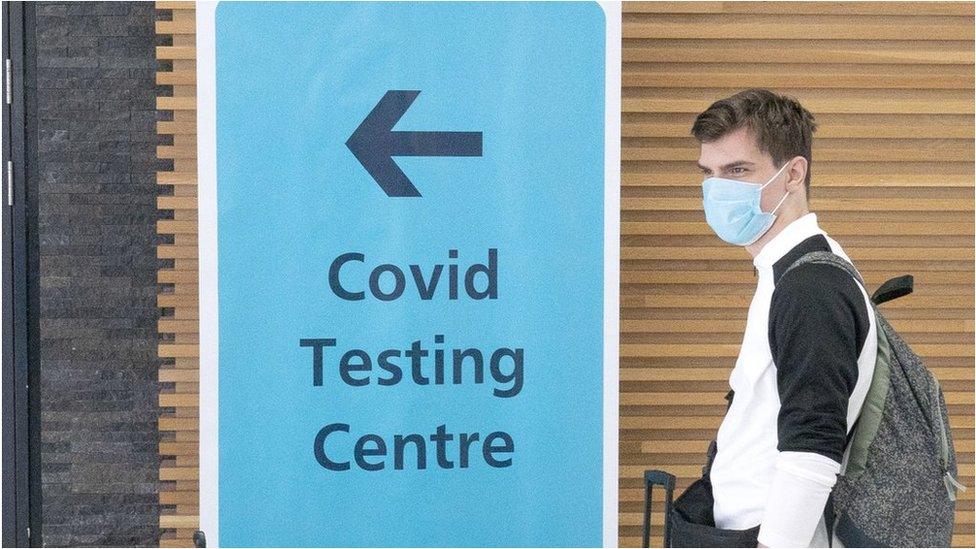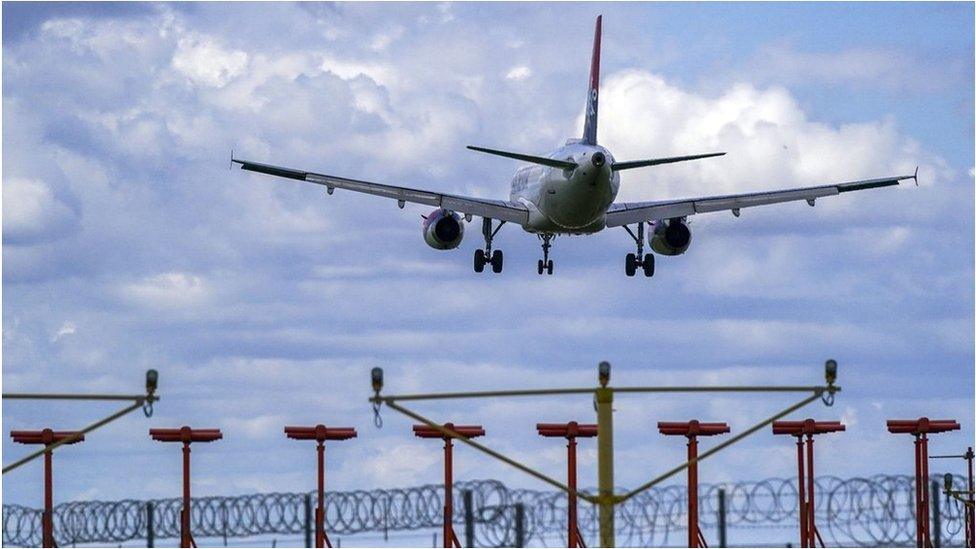Why is so little sequencing of PCR tests being done?
- Published

Conservative MP Huw Merriman, who chairs the Transport Select Committee, has written to Health Secretary Sajid Javid asking about coronavirus testing of international travellers.
Among other things, he asked, external why such a small proportion of the polymerase chain reaction (PCR) swab tests taken by people arriving in the UK to see if they are carrying the Covid-19 virus were being sequenced.
"The percentage of tests being sent for sequencing has fallen from 49% in early March to just 5% in early July," he said.
And although it is hard to get precise figures - because if fewer than three tests are involved no number appears in the official statistics - he is roughly right.
The government has repeatedly said travellers need to take PCR tests instead of the cheaper lateral-flow tests because it is important for positive tests to be sent for the genome sequencing used to identify new variants of the coronavirus.
BBC News has also been asking the Department of Health and Social Care (DHSC) why such a small proportion of positive tests are sequenced.
On Sunday, a DHSC official responded: "All positive tests for arrivals from red-list countries are sequenced," and the proportion for amber- and green-list countries was above 95%
What do the figures show?
The weekly NHS Test and Trace statistics, external include the number of positive tests from arrivals in England sequenced.
For arrivals from red-list countries between 1 and 21 July, they show:
Bangladesh - fewer than three of 54 positive tests sequenced
India - five of 49 positive tests sequenced
Pakistan - nine of 67 positive tests sequenced
South Africa - fewer than three of 45 positive tests sequenced.
Compare that with the period 18 March to 7 April:
Bangladesh - 39 of 96 positive tests sequenced
India - 234 of 556 positive tests sequenced
Pakistan - 640 of 1,380 positive tests sequenced
South Africa - fewer than three of 10 positive tests sequenced.

So what is going on?
The DHSC has said: "All viable red-list arrivals samples are being sent for sequencing."
And the word "viable" may be important here.
To detect whether any Covid genes are present, PCR tests are put through a number of cycles in a lab.
The more cycles it takes to detect the virus, the less of it is present, which is referred to as having a lower viral load.
If the coronavirus is detected within 40 cycles, the test counts as positive.
The number of cycles needed is known as the cycle-threshold (CT) value.
But the government says tests need to be sent for genome sequencing only if the virus is detected within 30 cycles.
So the positive tests with the lowest viral loads are not sent for sequencing.
And that is a basically sensible idea.
"We do not routinely sequence samples with a CT value greater than 30 because of sequencing failures that occur when there is only a small amount of virus in the sample," Covid-19 Genomics UK Consortium director Prof Sharon Peacock, of the University of Cambridge, told BBC News.
The consortium has conducted much of the UK's sequencing but the tests of travellers arriving in the UK are sequenced by a different group.
Dr Simon Worrell, global medical director for Collinson, which provides lots of the tests used by travellers, told BBC News the average CT count for his customers has consistently been hovering around the 30 mark, since the company began implementing testing at airports, towards the end of last year.
But this still does not explain why such a high proportion of travellers turn out to have viral loads too low to test.
One possible explanation is people in the early stages of infection tend to have lower viral loads.
And the people being tested on arrival in the UK will also have had to have had pre-departure testing before being allowed on the plane, so they are more likely to be in the early stages of the virus.
But that still does not explain why there was so much more sequencing being conducted in March and April than there is now.
It is possible that it is because people have lower viral loads in general, as a result of the vaccination programme.
But we do not have the figures to be able to confirm or disprove this.
We have been unable to get an explanation from the DHSC - and so has the chairman of the Transport Select Committee.

A SIMPLE GUIDE: How do I protect myself?
WHAT WE DON'T KNOW How to understand the death toll
TESTING: Can I get tested for coronavirus?
LOOK-UP TOOL: Check cases in your area



